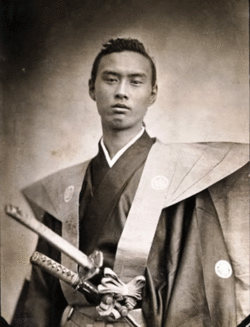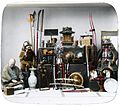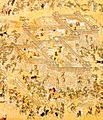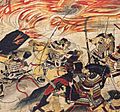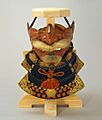Samurai facts for kids
The samurai (or bushi) were Japanese warriors who were members of the important military class before Japanese society changed in 1868. The samurai were also considered to be a type of hereditary nobility.
The word samurai comes from the Japanese verb saburau, which means "to serve and look up to someone."
History
In the 12th century, two military clans, the Minamoto and the Taira, were very powerful. They controlled Japan and fought wars against each other. In 1192, Minamoto no Yoritomo became the first shogun. He became the ruler of all of Japan and started a new government in Kamakura. The Kamakura government lasted from 1185 to 1333. It made the samurai the ruling class of Japanese society.
The samurai fought many wars in the Warring States period (1467-1573). There were many independent areas in Japan that fought one another all the time and so Japan needed many samurai. Many of the famous samurai movies by Akira Kurosawa were about this time.
Toyotomi Hideyoshi won many wars against other clans. He made Japan one country and developed a social caste system. It was completed by Tokugawa Ieyasu and the rulers after him. Between the wars, many samurai had always worked on farms. Hideyoshi said that all samurai must either live on farms or live in castle towns with other warriors. He also made a law that only samurai could have swords.
The samurai became very powerful and important near the end of the Edo period (1603-1867) and during the Shinto period. In the Edo period, they were the most important social caste. All samurai had to live in castle towns. Some of them had lords who paid them with rice, but others did not have lords and were called "rōnin". The "rōnin" caused problems for Japan in the early Edo period.
In 1615, the Tokugawa an won a very important battle when he took Osaka Castle. It has no rivals and so Japan became very peaceful for about 250 years. Military skills became less important, and most samurai became bureaucrats, teachers or artists.
In 1868, feudalism ended in Japan, which ended the samurai class.
Weapons
Weapons used by the samurai included:
- Japanese swords, (katana)
- The yumi (longbow)
- Firearms from the 16th century
- Cannons
- Pole weapons bearing blades, and spears
- Staff weapons (no blades)
- Clubs and truncheons
- Chain weapons
Beliefs
A samurai believed that his swords held his soul and so his sword was the most important thing that he had.
Samurai were allowed to fight anyone who did not show them proper respect. Every sword had to be tested for sharpness. To do so, the owner of the sword could execute a criminal.
Samurai led their lives according to the ethical code of bushido ("the way of the warrior"). That meant loyalty to one's master, self-discipline, respect, and ethical behavior. When a samurai lost his master, also called daimyo, he became a rōnin.
If a samurai was defeated or dishonored himself by not following the code of bushido, he had to commit seppuku (ritual suicide). Part of the seppuku ritual was cutting his stomach or abdomen. That part of the ritual is called hara-kiri. For a samurai, death was better than having no honor or being captured by the enemy. Another reason for committing Seppuku was the death of the daimyo. With that ritual, a samurai showed how loyal he was to his dead master. There were periods in which seppuku was forbidden, but some samurai still committed it.
The bushi's training methods, like meditation, judo and kendo, are still followed today. There is no longer a samurai class in modern Japan, but their families' successors are still well-respected.
Women
Samurai women were trained to defend themselves and their children. They usually did so when their warrior husbands were busy in battles. Sumurai women were therefore trained to handle polearms (naginata) and short daggers (tanto). During the Edo period, Japanese women were trained to handle naginata by the age of 18. The short kaiken knife was used by young women to defend their virtue or, if they lost it, to take their own life.
During the Edo period, women's education became very important. Girls were taught from a young age to write, read, dance, etc. The main criteria for marriage changed, but among the most important were physical attractiveness and education. Special books were written for women. They taught mainly how to take care of house and children. By the end of the Edo period, women attended philosophical and literary classes.
The term "samurai" refers to males specifically, but here were a few women who were samurai. One of the most famous was Itagaki, who lived during the end of the Heian period. She owned her own army of about 3,000 warriors. In 1199, Itagaki fought against 10,000 Heike soldiers. She was famous for being very good at handling the naginata sword.
Hino Tomiko ruled in place of her husband, Ashikaga Yoshimasa (8th shogun).
Toyotomi Hideyoshi's mistress became the master of Osaka Castle after his death.
Yamauchi Kazutoyo's wife, Chiyo, was one of the most loyal wives known in Japanese history. She supported her husband during hard times and saved to buy a horse for him. Yamauchi Kazutoyo never took a mistress, though it was a known tradition for a samurai. He never left Chiyo even though she had only one child.
Related pages
Images for kids
-
Samurai in armor in the 1860s; hand-colored photograph by Felice Beato
-
Kofun period helmet, gilt copper, 5th century, Ise Province
-
In the noh drama Sanjō Kokaji, the 10th-century blacksmith Munechika, aided by a kitsune (fox spirit), forges the tachi (samurai sword) Ko-Gitsune Maru.
-
Samurai ō-yoroi armor, Kamakura period. Tokyo National Museum.
-
Men and women engaged in battle (16th century illustration).
-
Himeji Castle, built from 1333 by the samurai Akamatsu Norimura of the Akamatsu clan.
-
A hatomune dou from the 16th century, the historic armor was once used by Kenshin Uesugi, one of the most powerful daimyōs of the Sengoku period.
-
Battle of Nagashino (1575)
-
Korean and Chinese soldiers assault the Japanese-built fortress at Ulsan during the Japanese invasions of Korea, 1597
-
Toyotomi Hideyoshi, who would later command the invasion of Korea, leads a small group assaulting the castle on Mount Inaba. Print by Tsukioka Yoshitoshi.
-
The Battle of Sekigahara, known as "Japan's decisive battle" (天下分け目の戦い, Tenka wakeme no tatakai)
-
Kamei Koremi, a samurai and daimyō in the bakumatsu period
-
A studio photograph of a samurai, taken by Italian–British photographer Felice Beato, c. 1860
-
Edo-period screen depicting the Battle of Sekigahara. It began on 21 October 1600 with a total of 160,000 men facing each other.
-
Kōan Ogata, a samurai, physician and rangaku scholar in late Edo period Japan, noted for establishing an academy which later developed into Osaka University.
-
Toyotomi Hideyoshi with his wives and concubines.
-
Gyokusen-en, Japanese garden made by a Korean samurai Wakita Naokata and his descendants.
-
Statue of samurai Kusunoki Masashige stationed outside Tokyo Imperial Palace.
-
Samurai of the Shōni clan gather to defend against Kublai Khan's Mongolian army during the first Mongol Invasion of Japan, 1274
-
Hangaku Gozen by Yoshitoshi, ca. 1885
-
Antique Japanese tachi
-
Antique Japanese katana
-
Antique Japanese wakizashi
-
Ō-yoroi, Kamakura period, 13th-14th century, Kasuga Grand Shrine, National Treasure
-
Dō-maru with Black and White Lacing. Muromachi period, 15th century, Tokyo National Museum, Important Cultural Property
-
Toyotomi Hidetsugu's gusoku armour, Azuchi-Momoyama period, 16th-17th century, Suntory Museum of Art
-
Karuta tatami dō gusoku, Edo period. A lightweight portable folding (tatami) armour made from small square or rectangle armor plates called karuta. The karuta are usually connected to each other by chainmail and sewn to a cloth backing.
-
Shell-shaped cask (Oitaragainari kawari kabuto), iron and papier-mâché for the shell, beginning of the Edo Period.
See also
 In Spanish: Samurái para niños
In Spanish: Samurái para niños



